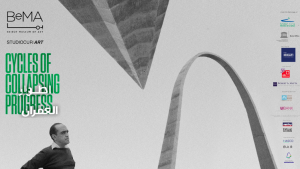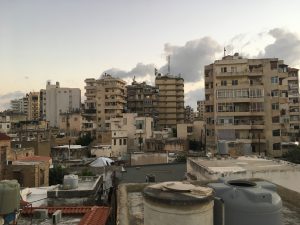
Attempting to Revive the Abandoned Art Scene of Tripoli
By: Alex Hall
In the aftermath of war, the rubble and political chaos often overshadow the detriment war can have on a city’s culture. In Lebanon, one loss that receives less attention is the fading of the thriving cultural and artistic scenes that its cities once attracted. Throughout the 1950s and 60s Lebanon was a meeting place for international artists and poets. In 1962, Tripoli received a visit from world-renowned Brazilian architect Oscar Niemeyer. Niemeyer was there to plan his design for Tripoli’s Rashid Karami International Fair. Construction of the fairgrounds began soon after, however, it came to a full halt at the breakout of the civil war in 1975, leaving an unfinished complex, whose original vision has never fully been realized.
While interning in Lebanon this summer, I took the time to explore this little-known complex with some fellow Fletcher colleagues. The fairgrounds are surrounded by a highwire fence, and appear completely abandoned from the outside. Although an Entrance Portico was planned with the intention of being a space for exhibitions, buyers, and visitors, most now enter through a small opening in the fence guarded by a single watchman. After being informed we were not allowed to take photographs without prior approval (a common request in Lebanon), we entered the complex.
The Fair Complex is a unique peek at modern architecture in a country that is characterized by the juxtapositions of ancient ruins, contemporary glass skyscrapers, and traditional villas. It is home to concrete structures and innovative forms that play on negative space and sound. And, sure enough, the complex reflects a recurring theme in Lebanon: places that limit public access are the best maintained by the city. Although the grey structures are decaying, one cannot find a more manicured lawn or clean promenade in this “public” space. One might wonder why so much care has been put into something that has, by all other signs, been left to deteriorate. Is it just another example of mismanagement of resources? Or, does it demonstrate control over a once-contested site? For, although there is little knowledge on the details, the complex was used by militants during the civil war, and even as a storage complex for munition by the Syrian Army; a history that is hard to research for lack of accessible information on the topic.
Despite never being the home to an International Art Expo, citizens have been trying to find other uses for the grounds. When they are occasionally used it is often for the purpose of celebrations and ceremonies, professional photo-shoots, and the occasional art exhibition or architecture studio-review. For instance, there is a exhibition organized by BeMA (Beirut Museum of Art) for the fall of 2018 titled “Cycles of Collapsing Progress”. The exhibition features a selection of Lebanese and Mexican artists, exploring “cyclical time and the cycles of collapse.” One of the artists presenting in the show is Lamia Joreige.
Lamia Joreige is an internationally-renowned contemporary artist, for whom I had the privilege to conduct research for this summer. Her work explores memories of the civil war and exposes varying truths that demonstrate the conflicting narratives of the country’s history. Her work for the exhibition at the Tripoli Fair will explore these topics in relation to the structures’ space. Although these initiatives to use the fairgrounds are noteworthy, it is hard to imagine a time in the near future when they may be used for their primary purpose. Tripoli is not a city that gains much, if any, art-tourism, and although the art scene is exploding in Beirut, compared to what it was immediately following the civil war, Tripoli has yet to witness such a revival. The few coffee shops and local initiatives to create space for art are often only used by a small elite population. Noting this, in developing ideas for the use of the fairgrounds, planners must think of ways to promote it as a public space that can attract a myriad of people from all corners of the city.


